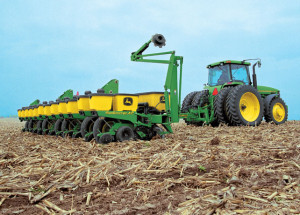As usual, farmers and traders alike braced for the USDA’s latest World Agriculture Supply and Demand Estimate (WASDE) numbers. Market corrections based on the monthly report’s numbers vary in intensity based upon how well they match up with pre-report, private estimates. While many question the impact of the USDA’s numbers for the longer term, the reports undoubtedly affect the grain markets for the short term, and whether the outlook is bullish or bearish.
The August report was released at 11 am on Tuesday, and the numbers reflect record production for both corn and beans. Farmers across the nation are estimated to grow 14 billion bushels of corn and 3.8 billion bushels of beans.
For corn, the record national average esti mate of 167.4 bushels per acre is still below the pre-report estimates. This brought ending stocks for 2013-14 corn to 1.181 billion bushels, and ending stocks for 2014-15 at 1.808 billion bushels, both below the range of pre-report estimate. Despite the record numbers, they were still slightly below trade expectations, and analysts are calling it slightly bullish for corn.
mate of 167.4 bushels per acre is still below the pre-report estimates. This brought ending stocks for 2013-14 corn to 1.181 billion bushels, and ending stocks for 2014-15 at 1.808 billion bushels, both below the range of pre-report estimate. Despite the record numbers, they were still slightly below trade expectations, and analysts are calling it slightly bullish for corn.
As far as corn yields are concerned, 11 states are expected to post new yield marks. The USDA also reported that ten key corn producing states have the highest number of ears on record so far. The estimated average cash price expectation for corn was lowered to 3.90 from 4.00. For soybeans, the WASDE report spelled bearish futures for soybeans and record-breaking production. Farmers will harvest 3.816 billion bushels of soybeans with a national average yield of 45.4 bushels per acre, the USDA said. This is 16 percent higher than last year.
As such, shortly after the report numbers were released, soybean trade numbers dipped double digits on news of the potential record crop. The report also indicated that the U.S. season-average soybean price for 2014/15 is forecast at $9.35 to $11.35 per bushel, down 15 cents on both ends.
The ending stocks estimate for 2013-14 soybeans was unchanged overall at 140 million bushels, although some numbers were changed in regard to supply and demand. As a result of the increased production estimates, the USDA increased ending soybean stocks for 2014-15 by 15 million bushels.
The report also indicated that Arkansas, Illinois, Louisiana, Mississippi, New York, Ohio and Pennsylvania could see record state soybean yields, and as of the end of last week, 71 percent of soybeans were rated in good to excellent condition, with development moving forward at a normal pace.
While these numbers are not good for beans, Al Kluis of Kluis Commodities cautions against making any rash decisions based upon quick market reactions after the report numbers are released. He reasons that the report’s estimates are not that far off of last month’s estimates, and the lower price trend has been underway for some time. Kluis notes, “If you’ve got hedges or crop insurance in place, there’s no reason to be panicking here. If we don’ t have an early frost, prices could bounce back in October.”
Do you have concerns regarding your land and the effects of the current report on the land rental rates? Let the experts at UFARM help.
United Farm and Ranch Management (UFARM) is a Nebraska-based company devoted to meeting landowners’ needs. UFARM offers a full range of Nebraska land management services, including real estate sales, rural property appraisals, consultations and crop insurance. UFARM has operated in Nebraska since the early 1930’s. Contact Us.
Sources consulted: Caldwell, Jeff. “Soybean Crop Size Flirting with a Record—USDA.” Agriculture.com. 12 Aug. 2014. Web. 12 Aug. 2014. Micik, Katie. “USDA Sees Record Corn, Soybean Crop.” DTN/The Progressive Farmer. DTN/Progressivefarmer.com. 12 Aug. 2014. Web. 12 Aug. 2014. “USDA reports record US corn, soybean production.” Reuters. CNBC.com. 12 Aug. 2014. Web. 12 Aug. 2014.

 Farmers across the nation are hard at work getting their crops into the ground as we head into the final two weeks of May. The latest USDA weekly crop progress estimates from Monday showed progress being made for both corn and soybeans over the last two weeks. In Nebraska, farmers have also moved forward and are slightly ahead of neighboring states despite various weather-related factors, chief among them being last week’s cold temperatures and some rainfall.
Farmers across the nation are hard at work getting their crops into the ground as we head into the final two weeks of May. The latest USDA weekly crop progress estimates from Monday showed progress being made for both corn and soybeans over the last two weeks. In Nebraska, farmers have also moved forward and are slightly ahead of neighboring states despite various weather-related factors, chief among them being last week’s cold temperatures and some rainfall.